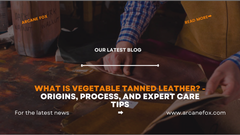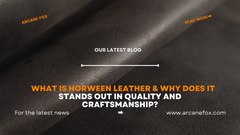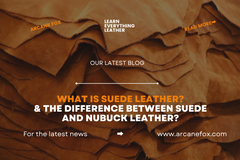What Is Shearling Leather? The Truth No One Told You About This Luxe Material

What Is Shearling Leather? The Truth No One Told You About This Luxe Material
Ever thrown on a jacket that felt like it hugged you back? That wasn’t just luck—it was probably shearling. And no, it’s not some made-up fashion buzzword. Shearling leather is the real deal. The kind of material that makes cold weather bearable and your outfit instantly cooler (without trying too hard).
But here’s the weird part—most people have no idea what shearling actually is. They just know it’s soft, warm, and usually costs more than dinner for four.
So, what is shearling leather, really? Is it just sheepskin with a fancy name? Is it magic? Or is it just really good marketing?
This post breaks it all down—how it’s made, why it’s pricey, and what makes it such a hit in the world of luxurious, durable outerwear. If you've ever wondered about the difference between shearling and sheepskin, or how to spot the real thing from the synthetic shearling (sherpa) knockoffs, you’re in the right place.
Let’s clear the fluff—literally.
1. What is Shearling Leather, Really?

Shearling leather is made from sheepskin or lambskin that’s been tanned with the wool still attached. Unlike Nappa or nubuck, shearling keeps its fleece, giving it a soft, plush feel and a naturally warm lining. The material is dual-sided—a suede exterior and wool interior—which makes it an excellent natural insulator for winter.
Its core benefits—breathability, warmth, and durability—make it ideal for shearling jackets, trench coats, and lined boots. It’s not just stylish—it’s smart.
Compared to synthetic options, shearling fur uses natural materials with less waste, and the tanning process aligns with traditional methods that focus on longevity and quality. That adds to its sustainability appeal, especially for conscious buyers.
So, what is shearling leather? It’s not just another fabric—it’s tanned sheep or lambskin crafted for comfort, warmth, and timeless luxury. Once you wear it, you’ll understand the hype.
2. How Shearling Leather Is Made – From Lamb to Luxe

It’s easy to admire shearling leather for how it looks and feels, but how it’s made is where the real magic begins. The process is careful, skilled, and full of intention—and that’s exactly what gives this material its unmatched quality.
2.1 From Farm to Tannery
Shearling starts as tanned sheep or lamb skin, often taken from yearling lamb pelt due to its softness and fine wool. The skin is carefully removed and immediately preserved to avoid damage. This is the first step in maintaining both sides of the hide—the suede exterior and wool interior.
2.2 The Tanning Process
Once preserved, the hide goes through the shearling manufacturing process. This includes vegetable tanning or other natural methods that keep the fleece intact while treating the leather side for strength. The wool is never removed. Instead, it's cleaned, softened, and sometimes trimmed to give that uniform, cozy finish we love.

2.3 Quality Finishing
Some types, like Nappa sheepskin leather, are polished for a smooth outer finish, while others stay suede-like for a rugged, casual feel. This final stage adds character—ensuring your shearling jacket or shearling coat has that signature blend of softness and structure.
The result? A luxurious, durable outerwear material that doesn’t just survive winter—it owns it.
From lamb to luxe, how shearling is made is a journey of craftsmanship that brings out the very best in natural comfort.
3. Key Characteristics & Benefits of Shearling Leather

What makes shearling leather more than just a cold-weather staple? It’s all in the details. From comfort to performance, this material blends nature’s best features into something that’s stylish, warm, and built to last. Let’s break down the core qualities that give shearling its legendary status.
3.1 Dual-sided comfort - suede exterior, wool interior
The magic of shearling lies in its dual-sided material. One side is soft suede or Nappa sheepskin leather, and the other is natural fleece. This combo offers warmth on the inside and texture on the outside—all in one single, continuous hide.
3.2 Naturally insulating and breathable
Shearling offers natural insulation that keeps you warm without overheating. Thanks to its thermal regulation, the wool fibers trap body heat while allowing air to flow, which keeps you dry and cozy in every climate.
3.3 Soft, plush feel with rugged durability
One touch of shearling leather and you’ll feel the difference. It’s plush like a blanket but tough enough to handle real wear. This balance of comfort and strength makes it ideal for everything from a shearling jacket to boots.
3.4 Long-lasting material that ages beautifully
Unlike synthetic fibers that break down, tanned sheep or lamb skin develops character over time. With the right care, shearling gets softer, richer, and better-looking with age—making it a smart long-term wardrobe investment.
3.5 Hypoallergenic and moisture-wicking qualities
Here’s a benefit most people overlook: shearling is naturally hypoallergenic. Its wool fibers wick away moisture and reduce bacteria buildup, making it great for sensitive skin and long wear. It’s one reason shearling maintenance/cleaning is easier than you’d think.
3.6 Wind-resistant and perfect for extreme cold
The fleece lining doesn’t just insulate—it blocks wind like a shield. That’s why shearling coats are a top pick for freezing winters. Whether you’re walking through snow or caught in a chilly breeze, this material holds its ground.
3.7 Luxurious texture with a timeless look
Fashion comes and goes, but shearling stays stylish. Its luxurious, durable outerwear appeal—along with its unique textures—makes it a staple in both high fashion and classic streetwear. From shearling dyeing and color options to cut and fit, there’s a version for every style.
So, when people talk about the benefits of shearling leather, they’re not exaggerating. This is one of those rare materials that brings together comfort, function, and timeless design—all backed by nature.
4. Real vs. Faux Shearling – Don’t Get Fooled

Real shearling leather is made from tanned sheep or lamb skin with the fleece still attached. It’s one full piece—suede exterior and wool interior—offering unmatched natural insulation and breathability.
Faux shearling (often called synthetic shearling or sherpa) is man-made, usually from polyester. While it may look similar, it doesn’t provide the same warmth, thermal regulation, or durability. Fake versions can feel stuffy, wear out fast, and lack the rich texture of the real deal.
Spot the difference by touch and seams. Real shearling feels dense yet soft. Faux ones tend to look overly uniform or plastic-like. And if the price seems too low? That’s your biggest clue.
If you want comfort that lasts, invest in genuine shearling—not just something that looks like it.
5. Why Shearling Leather Costs More (But Feels Like a Dream)

Shearling looks luxurious—and yes, the price usually proves it. But what you’re really paying for isn’t just appearance. It’s the quality, comfort, and craftsmanship that set shearling leather apart from anything else in your closet.
Here’s why it’s worth every penny:
- Made from tanned sheep or lamb skin with wool still attached.
- Involves a complex shearling manufacturing process, not quick factory work.
- Naturally offers thermal regulation and natural insulation.
- Known for its long-lasting durability—a jacket can last decades.
- Features a dual-sided material that’s warm, breathable, and weather-ready.
- Often crafted using sustainable tanning methods with less waste.
- Premium versions like Nappa leather offer extra polish and softness.
- The fit, feel, and function are hard to match with synthetic fabrics.
Sure, the cost might feel high upfront—but once you wear it, you’ll get it. Shearling leather isn’t just another layer. It’s comfort, quality, and cold-weather confidence wrapped into one.
6. What Shearling Leather Is Used For?

When most people hear shearling leather, they picture a soft, cozy shearling jacket—and they’re not wrong. But this material does more than just keep you warm. Its natural insulation, comfort, and durability make it a go-to choice for all kinds of cold-weather fashion and gear.
Sheepskin jackets, for instance, are a winter staple that combine tough exteriors with plush interiors. Then there are biker-style shearling jackets, where edgy design meets cold-weather function—perfect for those who want warmth without giving up their attitude. You’ll also see distressed shearling jackets that add a vintage, worn-in vibe, blending rugged character with everyday wearability.
Beyond outerwear, shearling is used in gloves, boots, and even hats. It's also popular in women’s trench leather coats and as lining in bags and collars.
So, whether you prefer bold or classic, modern or vintage, shearling leather delivers fashion with function, every time.
7. Shearling vs. Sheepskin vs. Sherpa – Know the Difference

It’s easy to mix up shearling, sheepskin, and sherpa—they all sound warm and fuzzy, right? But each one is different in how it’s made, how it performs, and how long it lasts. If you’re shopping for quality, knowing the difference really matters.
Shearling leather is the real deal. It’s made from tanned sheep or lamb skin with the wool still attached. This creates a dual-sided material—one side is soft suede or leather, and the other is natural fleece. It’s durable, breathable, and built for a serious cold.
Sheepskin leather, on the other hand, is a broader term. Not all sheepskin products retain the wool. Some are just leather made from sheep hide, without the warm fleece. That’s where the difference between shearling and sheepskin becomes important—shearling always has the wool, while sheepskin might not.
Then there’s sherpa, which is totally synthetic. It’s designed to mimic wool but is usually made from polyester or acrylic. It may look cozy, but it lacks the natural insulation, thermal regulation, and breathability of real shearling. It’s cheaper, sure—but it won’t last or feel the same.
In short:
- Shearling = natural wool + leather, real and long-lasting.
- Sheepskin = real leather, may or may not have wool.
- Sherpa = synthetic imitation, warm but not breathable.
Understanding these terms helps you shop smarter—and makes sure you’re paying for the quality you actually want.
8. How to Care for Shearling Leather Products Like a Pro?

Shearling leather may feel luxurious, but taking care of it doesn’t have to be complicated. With the right steps, you can keep your shearling jacket or sheepskin coat looking great and feeling even better—year after year.
Here’s how to do it like a pro:
- Avoid soaking it – Water can damage the leather; shake off snow or light rain quickly.
- Use a soft brush – Gently clean the wool interior to remove dirt and fluff it back up.
- Spot clean stains – Dab with a damp cloth and mild soap; never scrub harshly.
- Let it breathe – Always air dry your shearling coat; no heaters or dryers.
- Store it properly – Use a padded hanger and cover with a cotton bag to avoid creasing.
- Condition the leather side – Use a leather conditioner occasionally to prevent cracking.
- Avoid plastic bags – They trap moisture, which can ruin both the leather and fleece.
Taking care of shearling leather is more about gentle habits than expensive treatments. Treat it well, and it’ll reward you with comfort, warmth, and lasting style.
9. Final Thoughts
Shearling leather isn’t just a winter trend—it’s a material that blends old-world craftsmanship with modern comfort. From its roots in tanned sheep or lamb skin to its place in today’s fashion scene, it delivers more than warmth. It brings character, durability, and real value to your wardrobe.
Whether you’re eyeing a biker-style shearling jacket, a distressed leather jacket, or simply want something that feels better than synthetic fluff, knowing what makes shearling special puts you ahead of the game. It’s not just about how it looks—it’s about natural insulation, long wear, and even shearling sustainability.
And let’s be honest, once you put it on, you’ll feel the difference. It’s soft without being weak, warm without being bulky, and stylish without trying too hard.
So if you’ve ever asked, “What is shearling leather?”, now you know—it’s not hype. It’s heritage, comfort, and luxury, all rolled into one.
Related Posts:
- Leather 101 - The Ultimate Guide to Different Types of Leather
- How is Leather Made? A Step-by-Step Guide of the Leather Tanning Process
- What is Cowhide Leather? Origins, Types, and Maintenance
- What is Goatskin Leather? Different Types of Goatskin, Quality, Durability and More
- What is Sheepskin Leather? Everything You Need To Know
- What is Lambskin Leather? The Ultimate Guide on Quality, Durability and More
- What is Exotic Leather? Origins, Types, Care, and more
- What is Calfskin Leather? It's Quality & Durability Against Other Leather!





